Some call the Maria Theresien Straße (or Strasse) the liveliest promenade in the world and almost all Austrians have named it as their favourite shopping destination. Dedicated to the powerful and only female ruler of the illustrious House of Habsburgs who was lovingly called Mother of Austria (Maria Theresa); the street strives hard to take on her vibrant personality. The street extends from the Triumphal Arch in the south to the Mark Gaben Street to the north… a graceful promenade that has granite paving and beautiful benches and street lamps made of wood and brass.
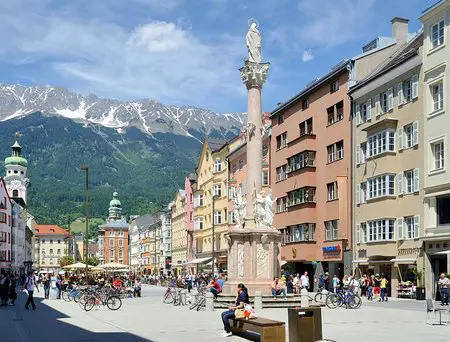
The charm of the street is accentuated by the presence of street musicians who keep playing guitar, violin etc. and breaking into impromptu songs. This very festive street will remind you of a never-ending carnival. The mountains definitely accentuate the beauty of this street and to enjoy them fully it’s always advised to walk north so that they remain in view throughout.
For most people who visit Innsbruck, a shopping jaunt and a stroll along the street is a tour highlight. For others just soaking up the ambience while sipping wine at the many cafes or capturing the views all around is a treat enough.
History
Once upon a time travellers crossing over the Brenner Pass from Italy and then moving on to Germany used the Maria Theresien Strasse as a passage. In those days just a few farmhouses dotted this part of ‘New Town’ of Innsbruck and in fact, a strong and thick wall shut this area off from the old town and the only connector was the St Jorgen gate. However, soon this empty space caught the eyes of the wealthy who wanted to remain in close proximity to the old town and yet wanted more space to showcase their artistic flair and wealth.
Later, the nobility and transport giants built spectacular houses along this street in Rococo/ Baroque/ Renaissance style displaying their wealth and power. Many of the buildings here (as you will read later) are the creations of famous architect Johann Martin Gumpp the Elder who was known for creating facades embellished with friezes, stucco and masks.
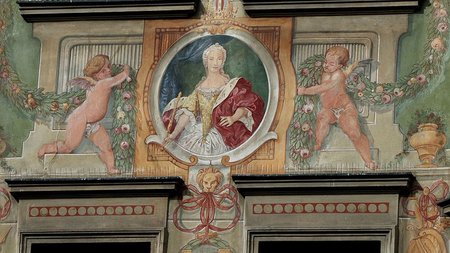
This street marks the expansion and prosperity of Innsbruck and in so many ways it was the city’s most distinctive mirror. The Maria Theresien Strasse saw many important events like the withdrawal of the Bavarian invaders after which the St Anne’s column was constructed in 1706. It also saw Maria Theresa ordering the construction of the Triumphal Arch in the southern end on the occasion of Leopold archduke with Spanish princess Maria Ludovica in 1765. Tyrolean freedom struggle rallies happened here as well as other important protests and marches.
However, it was in 1873 that the local council decided to have the name of the road changed to Maria Theresien Straße. Later the first steam-powered Lokalbahn Innsbruck hall was opened here as well as the first electric-powered tramlines. Gradually the road became the jugular vein of the city… its most important public transport corridor that was served by maximum bus and tram lines
Since 1978, Innsbruck city and Tyrol provincial authorities declared that Maria Theresien Strasse will be a conservation zone and no building can be demolished here. Major modifications to the street were made in 2009 when the street got brand new granite paving and street lamps and benches made of wood and brass were added. Other changes happened too like a new building for department store Tirol and the recent conversion of the northern area of Anichstraße into a pedestrian zone. The southern area is however still accessible by public transport though it has been prettily revamped.
Take A Stroll
You can walk to any part of Innsbruck from this street and many people prefer to walk to the Old Town to admire the Hofburg and Hofkirche …thus completing a cultural tour of the Habsburg dynasty. Another good idea will be to start the walk at Triumphal Arch at the junction of Maria Theresien and Maximilianstrasse and then walk past the St Anne’s Column while admiring the Nordkette mountain range towering over the Golden Roof.
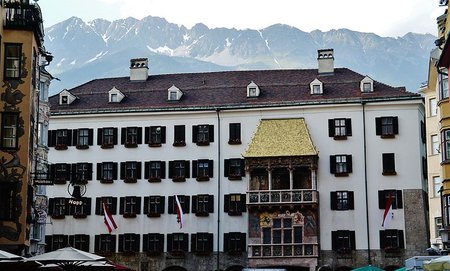
Look carefully and you can even see the Bergisel Ski Jump located to the south of Innsbruck directly in front of the Habicht and Serles mountains. Stop in between and pause to listen to the street musicians performing or just sit down on one of the antique benches for people watching.
Shopping
Maria Theresien Strasse is one of the best places to shop in Austria and two of the best retail jewels in its crown are the new age malls; Kaufhaus Tyrol and RathausGalerien.
Kaufhaus Tyrol was unanimously voted to be Europe’s best-looking shopping mall after it got a great makeover from David Chipperfield. Incidentally, the renovation included a fine facelift for the Sparkassenplatz square too that’s right behind the mall… this square is now often used to host events.
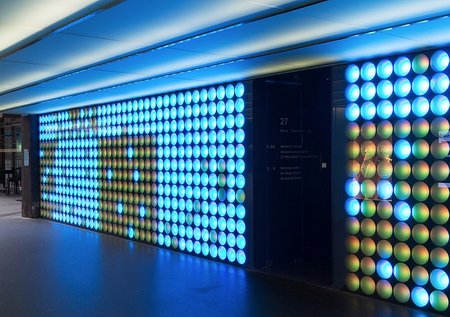
There are almost 50 shops here sprawled across the massive 30,000m² space along with some top-class restaurants. Brands to look out for here are Swedish fashion brands COS, Benetton, Esprit, H&M, P&C etc. There is a nice Children’s World Wiki on the 3rd floor where kids can play and spend time for free while new moms can breastfeed and warm up food. This mall is open from Monday to Saturday from 9 am to 6 /7 pm and has 3 parking lots.
RathausGalerien too got a beautiful makeover by Dominique Perrault and the lovely glass-roofed creation now has 24 high profile brands and 6 restaurants. Some brands found here include Betty Barclay, Lacoste, Northface, Vero Moda, Mango, By Fink’s Man, Rituals, Peak Performance, Appetit Jewellery etc. The name Rathaus refers to the town hall that’s on the north side of the shopping mall while there is a car park on the west side. The combination of the town hall, shops and restaurants in a single aesthetically refined structure is a unique concept.
The shopping centre can also be used as a shortcut to Anichstrasse and Adolf Pichler Platz that have many more shops, cafes and bars. Right at the top of the mall (7th floor), there is a great coffee bar shaped like a glass dome that provides 360-degree views that include excellent ones of the mountains and town apart from gourmet coffee and drinks. This mall is open from Monday to Saturday 9am to 7pm
If you need to see Maria Theresien Strasse at its prettiest then do target the annual Christmas Market that happens each year from late November to the first week of January. Glass, crystal and light installations come together to create a fairyland that bewitches adults and kids alike.
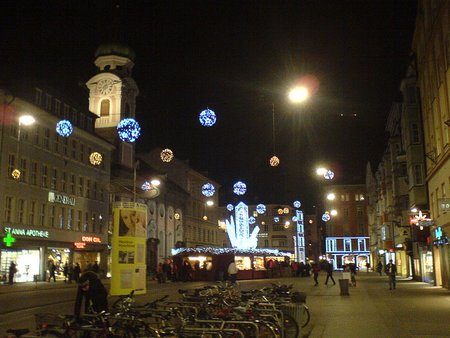
As many as 30 stalls selling everything from Christmas themed souvenirs to winter wear to home décor to delicious treats are set up and it’s a treat to sip that mug of spiced punch as you sit and enjoy the atmosphere outside. Look out for the sparkling mountain crystal that is positioned above the market and looks over the stalls.
If you are planning to go on to the old town for some more shopping then there is Swarovski Kristallwelten that offers a sparkling collection of jewellery, showpieces, crystal ware etc. and sparkling Argentinian wine sourced from Bodega Norton.
Restaurants & Cafes
Lots of cafes and restaurants line up the sides of Maria Theresien Straße and most people prefer to have a leisurely meal here to soak up the ambience. Try visiting the Lichtblick Gastro; it has one of the best wine lists in the city and a Zen-like ambience. Best and the freshest produce is used to create an ever-changing menu and there is an extraordinary view of Old Town on offer too.
The Piano Bar on the linked Herzog Friedrich Street is housed in an old and beautiful building and serves top-class Austrian cuisine. Try the local craft beer or fine wine with their steaks and pork Schnitzel.
Hard Rock Café with its cool and completely accessible set up is a must-visit …locals and tourists both love its music and ambience. Great portions with a nice casual menu including burgers, fries, stew and some unconventional entrees like Tupelo chicken and Hurricane cocktail. There are gluten-free/ vegan/child-friendly menu options too. The building will remind you of a Hogwarts set and you can sit outside and admire the St Anne’s column.
Right next door is the Orangerie with good hamburgers, grilled meat and a nice wine list. The nearby Das Schindler serves great German and Austrian food …the trout and gnocchi are both try worthy.
If you approach Maria Theresien Strasse from the train station then you will pass the Breakfast Club right after you get to the Servitenkirche. The best thing about this restaurant is that it serves a wide selection of savoury breakfast options and details them in multilingual menus. Norwegian omelette, rice pudding and almost everything here is delicious and there are options like soy milk, elderflower juice, detox ginger tea etc. for the health-conscious. Or else just turn up for a hearty traditional brunch with eggs, bacon, ham, waffles etc. Breakfast is just for 10 euros and it includes a glass of Prosecco too!!!
Notable Buildings
Old Hospital Church/ Spitalkirche is built at the entrance of the old town and the very beginning of Maria Theresien Strasse. Once upon a time this was outside the city and had an ancillary hospital with heavy walls separating them from the old town. The church was rebuilt by Johann Martin Gumpp the Elder and its earlier Gothic look got a modern twist though carved doors, stuccos and a Goth Cross still exists.
St Anne’s Column (Annasäule) is one of the most famous landmarks in this area. This column celebrates the historic moment when Tyrol defeated the Bavarian army invaders. The 17th-century Corinthian column is topped by a statue of Mary. The column is named St Anne’s as the date on which the military victory was achieved is Saint Anne’s Feast day i.e. July 26th. St Anne’s statue is at the northern side of the column facing the mountains.
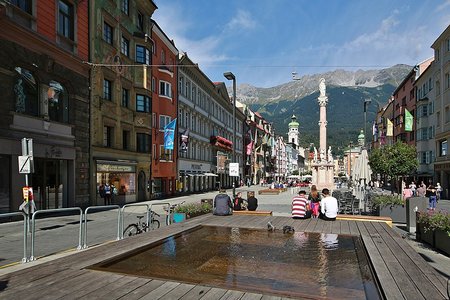
This structure has the same value for Innsbruck as London’s Piccadilly tower. As soon as you cross it you will find that the wide street thins down and morphs into Herzog Friedrich Strasse that later cuts through the centre of Altstadt (i.e. the old town). Beautifully preserved Burghers houses with gables and turrets and oriels can be seen here. And most of the houses have Dormer windows and extended protective roofs that shielded them against the snow.
The Altes Landhaus is a gorgeous Baroque palace that was built in 1728 and its extremely intricate Baroque façade is sure to catch your eye. The Provincial Assembly and Provincial Government House (Landesregierung) are now contained inside this Baroque building.
Palais Lodron was the home of Count Josef Nikolaus von Lodron … a member of South Tyrolean nobility. He bought two houses and combined them into a single stately palace that combined both Baroque and Rococo styles. When you pass it you will notice the bourgeois style 3 window fronts with central bay windows and the lovely stucco medallion of Virgin Mary Madonna.
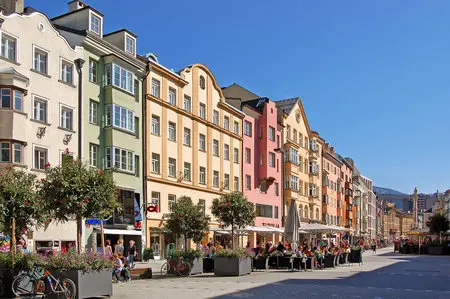
Look out for Gasthaus Alt Insprugg that’s a 15th-century baroque house rebuilt in 1906. The Gothic façade holds wooden copies of the statues of Arthur and Theodoric (the originals are found in Hofkirche). Palais Trapp stands directly opposite and thus was built in the 17th century for the Counts of the Trapp family… this is distinctive by its pretty inner courtyard that now has a fully functional café (café im HOF).
Palais Troyer-Spaur dates back to 1680 and is an excellent example of the baroque style. This is a 6 axle 4 storey building with a low attic and a distinctive façade with rich stucco work.
Palais Fugger-Taxis dates back to 1680 and was used by Count Hans Otto Fugger as a baroque palace though now its garden area contains the New Country House. Around 1905 the building was taken over by the government of Tyrol and now the grand Taxispalais Kunsthalle Tyrol (official gallery of contemporary Art) is housed here. Note the Tuscan columns with their lion sculptures and windows framed by lavish Stucco work. Walk in between 11 am to 6 pm to catch the exhibitions and if you come on Sunday there is free entry too!!
Peterlongo Haus (formerly called Palais Sarnthein) was designed in 1686 for David Count Sarnthein. The architecturally brilliant 4 storeyed red building was converted from an older townhouse to a palace.
Like Palais Trapp, Peterlongo Haus and Palais Troyer Spaur, the Palais Fugger Taxis was the creation of famed medieval architect Johann Martin Gumpp the Elder.
The Servite Church and Monastery that dates back to 1614 is one of the most important buildings here and its fresco of the Holy Trinity is especially striking. After a fire, this church was rebuilt in the 18th-century baroque style by Georg Anton Gumpp.
Of course, the Triumphal Arch at the north end of Maria Theresien Strasse is one of the best-known city landmarks. The serious-looking monument not only commemorates the marriage of Leopold and his Spanish wife but also mourns the death of Emperor Franz (Maria Theresien’s husband who died on the day of the wedding).
Notice that the southern side of the arch bears the medallion of Maria Theresa and Josef II while the north side bears the medallion of Leopold and his wife. The roof of the arch has some pretty neo-classical style nymphs. Note that beyond the arch, Leopoldstrasse begins and continues towards the Wilten suburb that has many small museums and Baroque churches.
How To Reach
Maria Theresien Straße is at the heart of Innsbruck and conveyance is just not an issue as all important transport networks access this street. You can travel by bus, lines D, DE, E, F, H, LK, OE, R, TS, A, C, J, LK, M, O, OE, N1, N2, N7, N8… all of these will take you to either end of the street . Or you can access the street by tram, lines 1, 3, 6 (Strassenbahn) after you take the exit at Anichstrasse.
If walking is not an issue then a 15-minute walk will take you from the main train station to the vibrant Maria Theresien Strasse. Simply walk out of Hauptbahnhof and cross the street using the crosswalk before turning right and walking down the next street to your left. Keep walking and you will reach Maria Theresa’s street. Keep walking some more and take a right turn and there is the Innsbruck City Centre and a short distance away there is the Goldenes Dachl… the perfect route for a great city walk.
Or you could take the Olympiastrasse and reach the Austrian Alpine Museum after a brisk 8-minute walk from Maria Theresien. The Austrian Alpine Association Museum (Alpenverien) has a great collection of Alpine art and climbing equipment dated back to historical times.
 A travel addict. Still celebrating the day when he quit his high-profile corporate job to pursue his passion for travel writing.
A travel addict. Still celebrating the day when he quit his high-profile corporate job to pursue his passion for travel writing.